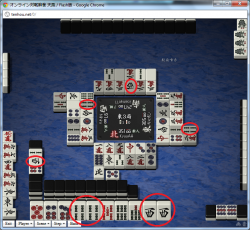Tenpai
Tenpai 「テンパイ」, or "ready hand" in English, is a hand that needs only one more tile to complete the hand. Once a hand is in tenpai, if it has a yaku, it may win by self-draw (tsumo) or by another player's discard (ron). A hand does not need a yaku in order to be considered tenpai, but it does need a yaku in order to win. Having achieving tenpai (with/without yaku) is worth some points when a hand ends in ryuukyoku.
The direct opposite of tenpai is noten 「ノーテン」, a contraction of not tenpai. A hand in this state has absolutely no chance of winning upon the immediate draw or discard. Instead, it relies on further tile draws and discards to attain the state of tenpai.
Recognizing that a hand is in tenpai is one of the most important concepts in the game. Without it, a player will lack the ability to make the best decisions on which tiles to best discard.
Tenpai conditions
Tenpai occurs under any of the four following conditions:
- Three tile groups and a pair (jantou). The fourth tile group needs completion. A majority of wait patterns fall under this condition.
- Four tile groups and a single tile (tanki). Completion occurs when a duplicate of the pair is drawn or discarded.
- Chiitoitsu. Six distinct tile pairs and a single tile (also tanki).
- Kokushi musou.
Wait patterns
Every hand in tenpai involves some sort of wait pattern, or machi. Common types of wait patterns are named for easy use and recognition. Choosing your wait, if able, helps with gameplay.
Jantou
Jantou are the tile pairs to a mahjong hand. Every hand, open or closed, requires at least one tile paired. The pair must already be in the hand by tenpai, or waiting to be completed. If the pair is not completed, it is a tanki wait.
Example tenpai hands
1.Waiting for:
or

2.Waiting for:
,
or

3.Waiting for:
,
, or

4.
Waiting for:
, or

5.
Waiting for:

6.
Waiting for:

Examples 1, 2, and 3 are closed tenpai hands. They can all declare riichi to gain a yaku. In addition, if they win via self-draw, they'll gain the yaku of menzen tsumo. The first two already possess yaku without needing riichi, but the third does not. Therefore, the third hand needs riichi, menzen tsumo, or a conditional yaku like houtei to win.
Examples 4, 5, and 6 are open tenpai hands. Example 4 and 5 can both have yakuhai. Example 4 certainly has a yaku, via the open call on the green dragon. Example 5 could have a yaku, if the hand is seated west or the game is in the west round. The last example does not have a yaku, however, so it cannot win under normal conditions. It will need a conditional yaku (haitei, houtei, rinshan, or chankan) to win at all.
Karaten

Karaten 「カラテン」, or empty tenpai, is a state where a tenpai hand is unable to win because every winning tile is "visible" (and thus unavailable). "Visible" tiles include tiles discarded, used as a dora indicator, in an opponent's tile call, and tiles already in the hand. While a tile may be unavaible if in an opponents hand, or in the dead wall, these would be unknown to the player.
Keishiki tenpai
Keishiki tenpai 「形式聴牌」, or shaped tenpai, are tenpai hands without any yaku. While these hands cannot win normally, they are still considered tenpai for the tenpai vs noten payment done at ryuukyoku. Even if a hand has no built-in yaku, it may still win with a conditional yaku (haitei, houtei, chankan, rinshan).
This is a common pitfall for many beginners. A new player might build a hand to tenpai, but due to limited knowledge of yaku, are unable to declare a win.
Ryuukyoku
When every tile (except in the dead wall) has been drawn, the game ends in exhaustive draw. Afterwards, players in tenpai can choose to reveal their hands. Any players in noten have to pay the players in tenpai.
Agari
Agari 「和がり」 is the general call for a winning hand. Two types of winning calls are more commonly used, depending on the source of the tile:
Proper tenpai hands have a right to make these winning calls. In doing so, players must know which tiles and yaku are needed for a win. Likewise, the recognition of waiting tiles is a necessity to call on the correct tile. Otherwise, improper calls for winning hands result in chombo.
Iishanten
Iishanten, or 1-shanten, is the state of the hand before attaining tenpai. While tenpai is 1-tile away from winning the hand, iishanten is 1-tile away from attaining tenpai.
Iishanten is closest state a hand can get to tenpai, and is thus acts as a critical juncture. Going from iishanten to tenpai is the slowest stage of the hand, so maximizing the chance of escaping iishanten is usually good. Players often need to choose whether to riichi or stay damaten, and if another opponent is in tenpai, whether to push or fold.
External links
- Tenpai in Japanese Wikipedia
| |||||||||||